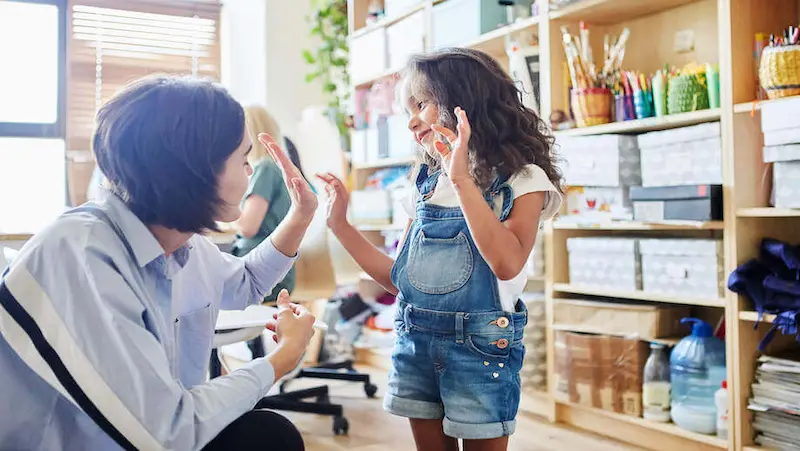Welcome, parents! In this blog, we will learn important tips about positive behavior reinforcement for kids. As parents, we understand that our kids’ behavior is important for their future, and building positive behavior will be beneficial for their overall development.
By implementing effective behavior modification techniques and positive reinforcement strategies, we can create a nurturing environment that sets the stage for a brighter future! Stay tuned with me, and together we will explore the power of reward-based training methods and highlight the significance of using positive, encouraging approaches to guide children towards desirable behaviors.
Table of contents
- Understanding Positive Behavior Reinforcement
- Setting the Stage for Positive Behavior Reinforcement
- Identifying Target Behaviors
- Effective Positive Reinforcement Techniques
- Implementing Positive Behavior Reinforcement in Everyday Life
- Dealing with Challenges and Pitfalls
- Conclusion
- Frequently Asked Questions
Understanding Positive Behavior Reinforcement
As a parent, guardian, or educator, one of the most crucial tasks we face is shaping a child’s behavior. It’s a challenge that often keeps us awake at night, wondering if we’re doing it right. Should we be strict and disciplined, or should we try a more positive approach? While there’s no one-size-fits-all answer, I’d like to explore the incredible benefits of using positive reinforcement to guide a child’s behavior.

1. Builds Stronger Relationships: Positive reinforcement fosters a bond built on trust and mutual respect. When children experience consistent praise and encouragement, they feel valued and loved. This, in turn, strengthens the relationship between adults and children, making it easier to communicate and collaborate.
2. Boosts Self-Esteem: Children who receive positive feedback and reinforcement are more likely to develop healthy self-esteem. When they hear that their efforts and achievements are appreciated, they begin to believe in their abilities and are more willing to take on new challenges.
3. Motivates Desired Behavior: Rather than focusing on what a child is doing wrong, positive reinforcement centers on what they’re doing right. By rewarding good behavior, you increase the likelihood that the child will repeat it. This motivates them to make positive choices and act in ways that align with your expectations.
4. Teaches Emotional Regulation: Positive reinforcement helps children understand their emotions better. When they receive praise for controlling their anger management for kids or showing empathy, they learn that these behaviors are not only expected but also rewarding. This understanding can lead to better emotional regulation for kids over time.
5. Encourages Intrinsic Motivation: Unlike punitive methods, which often rely on external factors like fear or punishment, positive reinforcement taps into intrinsic motivation. Children start behaving well not because they’re afraid of getting into trouble, but because they genuinely want to do the right thing.
Setting the Stage for Positive Behavior Reinforcement

Clear Communication: The Bridge of Understanding
Imagine a world without clear communication – it would be like a ship lost at sea with no compass. Clear communication is the bridge that connects our thoughts, ideas, and emotions to others. It’s not just about speaking fluently; it’s about conveying our message in a way that others can grasp, without room for misinterpretation.
When we communicate clearly, we unlock the door to mutual understanding. We share our thoughts and feelings openly, and we listen actively. This exchange of ideas fosters trust and empathy.
Consistency: The Glue that Bonds
Consistency is the quiet guardian of reliability. It’s about doing what you say you will, time and time again. Consistency builds trust and predictability, creating a stable foundation for any relationship.
In our personal lives, consistency means being there for our loved ones, following through on promises, and being dependable. In the professional realm, consistency equates to meeting deadlines, delivering quality work, and being a reliable team member.
Setting Realistic Expectations: The Path to Fulfillment
Setting realistic expectations is akin to drawing a roadmap for success. When we set expectations that are grounded in reality, we’re less likely to be disappointed, and we open ourselves up to a world of possibilities.
In relationships, it’s important to be clear about our needs and boundaries. Unrealistic expectations can lead to disappointment and resentment. On the job, setting realistic expectations for ourselves and others ensures that goals are attainable and that we’re not setting ourselves up for failure.
Identifying Target Behaviors
One of the key ways we can help shape their future is by reinforcing positive thinking for kids behaviors. It’s not just about disciplining negative actions; it’s about recognizing and encouraging the good ones. In this blog post, we’ll explore how to identify specific behaviors you’d like to reinforce in your children and offer some tips to make this journey as smooth as possible.

1. Observe and Understand
Before you can reinforce positive behaviors, you need to know what those behaviors are. Start by observing your child closely in various situations. Watch how they interact with others, how they handle challenges, and how they respond to your guidance. This observation will help you pinpoint the specific behaviors you want to reinforce.
For example, you might notice that your child is particularly empathetic when a friend is upset or that they are diligent in completing their homework without being reminded. These are the behaviors you want to encourage and reinforce.
2. Prioritize Core Values
As parents, you likely have a set of core values that you want to instill in your children. These values could include honesty, kindness, responsibility, respect, and perseverance, among others. Identify which values are most important to your family, and then look for behaviors that align with these values.
For instance, if honesty is a core value for your family, you might want to reinforce behaviors like telling the truth even when it’s difficult or admitting mistakes and taking responsibility for them.
3. Set Clear Expectations
Children often thrive when they know what’s expected of them. Once you’ve identified the specific behaviors you want to reinforce, communicate your expectations clearly to your child. Use age-appropriate language and examples to help them understand.
For example, if you want to reinforce the behavior of sharing, you can say, “We believe sharing is important in our family. When you and your friend both want to play with the same toy, we expect you to take turns.”
4. Catch Them Being Good
It’s easy to notice when your child misbehaves or breaks the rules, but don’t forget to catch them being good. When you see your child exhibiting the behavior you want to reinforce, make sure to acknowledge and praise them for it. This positive reinforcement can be as simple as saying, “I noticed how patient you were when your little sister was upset. That’s very kind of you.”
5. Be Consistent
Consistency is key when reinforcing positive affirmations for kids. Children need to know that the rules and expectations are the same day in and day out. If you praise a behavior one day and ignore it the next, it can send mixed signals.
Effective Positive Reinforcement Techniques

Verbal Praise: The Gift of Words
Have you ever felt your heart swell with happiness when someone appreciated your efforts? That’s the magic of verbal praise. It’s one of the simplest yet most effective forms of positive reinforcement. Just a few genuine words of encouragement can go a long way in motivating someone to keep up the good work.
Imagine you’re at work, tackling a challenging project. Your boss comes by and says, “Great job on the presentation. You really nailed it!” How would that make you feel? Pretty awesome, right? You’d probably be more inclined to put in that extra effort next time. Verbal praise creates a positive affirmations for kids emotional connection that boosts self-esteem and encourages continuous improvement.
Rewards: The Cherry on Top
Now, let’s talk about rewards – the tangible symbols of appreciation. Rewards come in all shapes and sizes, from a gold star sticker on a child’s homework to a bonus at work for a job well done. These incentives make us feel valued and appreciated for our efforts.
Think about when you were a kid and got a treat for acing a test. You associated success with that delicious ice cream or that shiny toy, and it motivated you to study harder. As adults, the principle remains the same. Rewards provide us with an extra push to achieve our goals and sustain our positive behaviors.
Incentives: The Extra Push
Incentives are like the carrot dangling in front of the horse – they give us that extra motivation to reach a desired outcome. They work particularly well when we need a little extra nudge to get started on something challenging or to maintain a consistent habit.
For example, your gym offers you a discounted membership if you commit to working out three times a week. Knowing you’re saving money while getting fit can be a powerful incentive to keep hitting the gym regularly. Incentives help us set and achieve targets, turning them into habits.
Implementing Positive Behavior Reinforcement in Everyday Life

1. Start with Self-Reflection:
Before we can reinforce positive behaviors in others, we should start with ourselves. Take a moment each morning for self-reflection. Consider your goals for the day and how you can reward yourself for achieving them. It could be as simple as treating yourself to a favorite snack or taking a moment to savor your achievements.
2. Catch ‘Em Being Good:
Incorporating positive reinforcement begins with noticing and acknowledging the behaviors you want to encourage. Be on the lookout for those moments when someone – a colleague, child, or friend – does something you appreciate. Offering genuine praise, like saying “I really appreciate your hard work on this project,” can go a long way in reinforcing positive behaviors.
3. Be Specific and Sincere:
When you’re offering praise or rewards, be specific about what you’re acknowledging. Instead of a generic “good job,” say something like, “I noticed how you stayed focused and met that deadline; that was impressive.” Being sincere in your praise adds authenticity to your reinforcement.
4. Create a Reward System:
One of the most effective ways to incorporate positive reinforcement is by creating a reward system. This can work wonders at home and in the workplace. For example, if you’re trying to encourage your child to complete their homework on time, consider a reward like extra playtime or a special treat once they finish their tasks.
5. Consistency is Key:
For positive reinforcement to be effective, it needs to be consistent. Ensure that you’re consistently rewarding desired behaviors, so the individual knows what to expect. This consistency builds trust and encourages the repetition of those behaviors.
Dealing with Challenges and Pitfalls

1. Consistency Conundrum:
One of the biggest challenges in using positive behavior reinforcement is staying consistent. Imagine you’re trying to teach your child to say “please” and “thank you.” You praise them when they do, but sometimes you’re in a hurry or distracted, and you let it slide. Inconsistent reinforcement sends mixed signals, making it harder for the behavior to stick.
Solution: Make a conscious effort to be consistent. Set clear expectations and stick to them. If you slip up, don’t be too hard on yourself, but do your best to get back on track. Consistency is key to reinforcing positive behavior effectively.
2. The Dilemma of Rewards:
Another challenge is deciding when and how to reward good behavior. You might worry that offering rewards will make your child or student expect something in return every time they do something right.
Solution: Balance is crucial here. While rewards can be helpful, they should not be overused. Sometimes, a simple “Great job!” or a high-five is reward enough. Reserve bigger rewards for more significant milestones to prevent the expectation of constant rewards.
3. Patience Predicament:
Positive behavior reinforcement takes time, and sometimes it feels like we’re not making any progress. You might find yourself wondering if it’s even working.
Solution: Patience is indeed a virtue in this journey. Remember, behavior change is gradual. Keep track of small improvements and celebrate them. Trust the process, and over time, you’ll see positive habits changes taking root.
4. Overcoming Resistance:
Children, like all of us, have their moments of resistance. They might push back against your efforts toreinforce good behavior, testing your patience.
Solution: When faced with resistance, stay calm and firm. Explain the reasons behind your expectations and the benefits of positive behavior. Avoid power struggles and give them some control within limits, like allowing them to choose between two suitable options.
5. Peer Pressure Predicament:
As kids grow, they become more influenced by their peers. Sometimes, the positive behavior you’ve reinforced at home or in the classroom doesn’t carry over into social settings.
Solution: Encourage open communication. Discuss the importance of their behavior choices in different situations. Teach them how to stand by their values and make responsible choices, even when faced with peer pressure.
Conclusion
In conclusion, harnessing the power of positive behavior reinforcement, through behavior modification techniques, positive reinforcement strategies, reward-based training methods, and a focus on encouraging positive behavior is a transformative approach to raising children. By creating a positive and nurturing environment, we can effectively shape our child’s behavior and promote their long-term development.
Balancing positive reinforcement with appropriate disciplinary measures, while emphasizing intrinsic motivation and self-discipline, allows our children to grow into responsible and resilient individuals. By investing in positive behavior reinforcement, we lay the foundation for a happier and well-adjusted child, fostering character development and paving the way for a bright future.
Also, BrightChamps provides a comprehensive platform for learning about money for kids, offering interactive and engaging resources that teach financial literacy, budgeting, saving, and other essential money management skills.
To get your hands on more educational and free resources on coding for kids, robotics for kids, financial education for kids, etc., do check out the BrightCHAMPS Page now!
Frequently Asked Questions
A1. Positive behavior reinforcement is a technique that involves rewarding desired behaviors in children, which is important because it motivates children to do that behavior repeatedly.
A2. Positive behavior reinforcement focuses on encouraging desired behaviors, while punishment or negative reinforcement focuses on discouraging undesired behaviors.
A3. Give them genuine verbal praise whenever they speak politely, or spend time playing with them after they have finished studying.
A4. Positive behavior reinforcement creates a connection between positive actions and rewards, motivating children to repeat those actions. It helps children understand which behaviors are desirable and reinforces their confidence and self-esteem when they exhibit positive behavior.
A5. Relying too heavily on rewards or being inconsistent with reinforcement can lead to children becoming dependent on external motivators. It is important to gradually transition to intrinsic motivation and use positive reinforcement in balance with other forms of guidance and discipline.
A6. Parents can implement positive behavior reinforcement by setting clear expectations, using consistent reinforcement, providing specific and timely feedback, establishing routines and rules, and creating a nurturing and supportive environment that fosters positive behavior.
A7. Being specific and genuine with praise, tailoring rewards to our child’s interests (but don’t use bad habits as rewards!), maintaining consistency, gradually reducing the reliance on external rewards, and focusing on intrinsic motivation and self-discipline.
A8. Creative ways to reward positive behavior may include special outings, quality time with parents, allowing them to choose a family activity, providing small surprises or privileges, or creating a reward system that aligns with their interests and preferences.
















